Unlike other birds, the Shoebill Stork is one of the most impressive yet intimidating birds. But what makes the shoebill stork one of the most fascinating birds is its long and deadly shoe-shaped beak, tall and large body shape, and prehistoric appearance with extraordinary survival skills.
The Shoebill bird almost looks unreal, but hey! It is very much a real bird. So, let’s explore some mind-blowing facts you’ve never heard before.
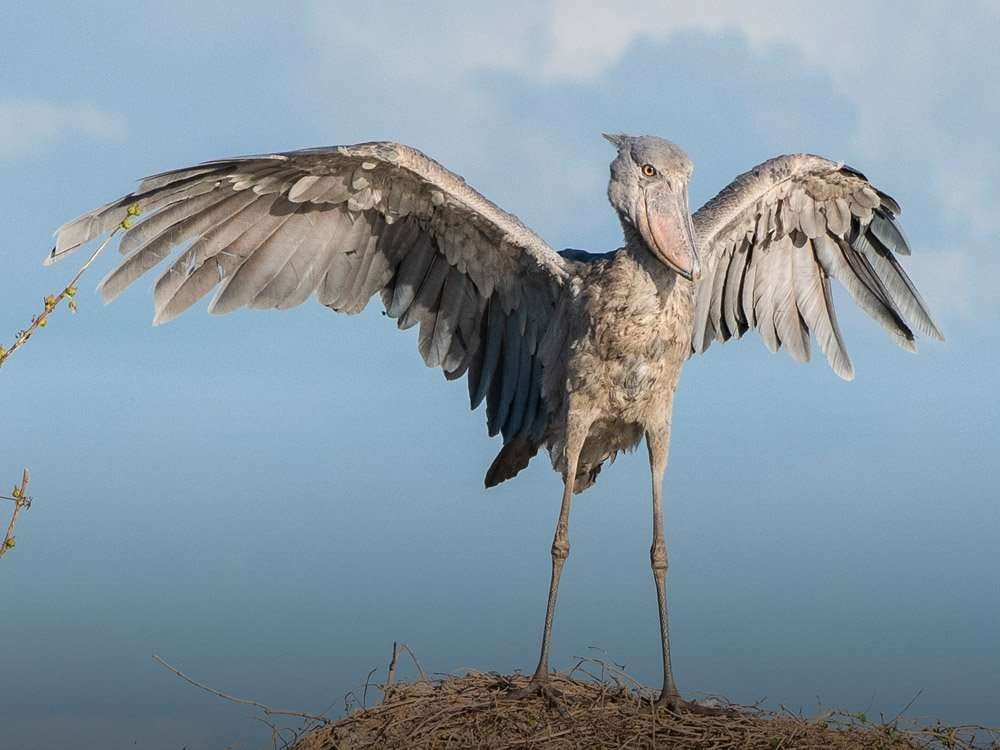
1. Shoebill Stork Size: A towering Giant
Undoubtedly, it is a very tall and large bird with a maximum height of 5 feet. If we compare it with the world’s tallest bird, the ostrich, whose female has a height of 5 to 6 feet and the male has a height of 8 to 9 feet. Therefore, Shoebill Stork’s height is almost equal to that of a female ostrich.
Shoebills have a wingspan of up to 8 feet, providing maximum reach, lift, and stability during flight. They are stealthy predators, and their wide wingspan helps them fly smoothly and quietly, which is important for hunting.
Despite having such a large body and a height of 5 feet, it is surprising that shoebill weighs less. The main reason for this is its lean body structure and hollow bones. If we look at the shoebill stork weight, the male is slightly heavier than the female, although the difference is not much. The male shoebill weighs about 5 to 7 kg and the female shoebill weighs about 4 to 5.5 kg.
2. Shoebill vs. Crocodile: Can This Bird Really Hunt Crocs?
Shoebills are fierce and powerful and their large beak makes them deadly. Now the main question is, do shoebills attack crocodiles? Yes, Shoebill does attack crocodiles, but only baby or newborn crocodiles, not adult ones. Adult crocodiles weigh around 500 to 1000 kilograms, making them far too dangerous for the shoebill to challenge or prey on. Although, Baby crocodiles usually weigh 70 to 100 grams. They are young and vulnerable at the hatchling stage, making them easy targets for the shoebill.
The shoebill predator needs its powerful beak to hunt large prey, snakes, and other species and there is no doubt about that. But this is not the only thing that makes the shoebill a predator, but also its hunting strategy, stealth, patience, and quick reflexes.
Since this predator is found in wetlands and marshy swamps, its diet is primarily aquatic. That’s why shoebill hunting land mammals like antelope is entirely fictional. This predator sticks to prey it can handle and its hunting technique involves patience, stillness, and a quick, powerful strike at the prey, which does not apply to hunting antelope. And the antelope, being a land mammal, is a long way from becoming the prey of the shoebill.
3. Shoebill Diet: What Do Shoebill Storks Eat?
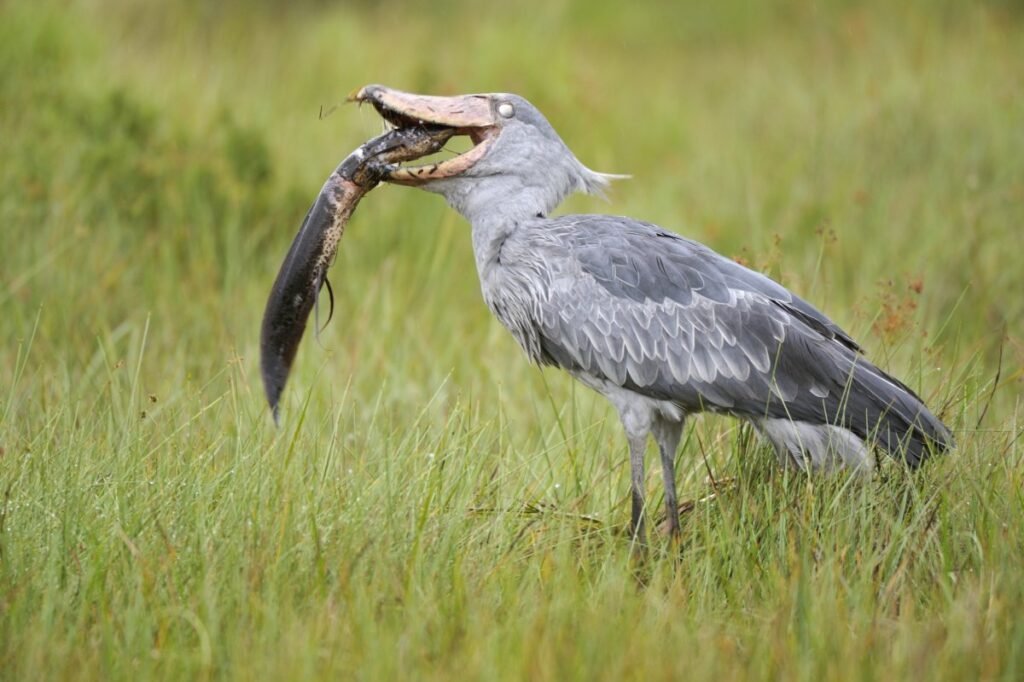
Shoebills are opportunistic hunters with an appetite for a unique diet; even though they are gregarious, their diet is typical for other birds. This bird is carnivorous and its favorite prey is lungfish found in shallow waters. Shoebill also preys on fish, reptiles, eels, frogs, water snakes, Nile monitors, and baby Nile crocodiles. Did you know that Nile crocodiles are also known for their strongest bite force and Shoebills prey on baby Nile crocodiles? Now you can imagine how formidable this creature is.
The shoebill’s diet primarily includes aquatic animals found in abundance in their habitat. Furthermore, these prey are slow-moving creatures found in deep shallow waters. The shoebill’s specific hunting techniques and tactics are perfect for these prey.
4. Shoebill Hunting Techniques: The Art of Stealth and Strike
To survive in the wild hunting is essential so let’s know how shoebill birds hunt. Shoebills employ an ambush hunting strategy, allowing their prey to never know they are following them. In this strategy, they wait patiently for hours and make a sudden attack which takes only a few seconds.
The key to the success of this strategy is standing motionless as this does not scare the prey and it helps the shoebill to blend into the environment. Standing still and patiently focusing on the prey with their eyes facing forward helps them understand the exact moment for a sudden and powerful attack on their prey. So, this is about the art of stealth.
Now the art of strike involves its most lethal weapon its shoe-shaped bill. The shoebill’s beak is large and broad, with razor-shaped edges and a hooked tip. The width of its beak and its shoe-shaped structure help it catch its prey quickly. The hook-like shape at the tip of the beak helps in piercing the prey quickly and swiftly while the razor-shaped edges help in a strong powerful biting force on the prey.
5. Are Shoebills Dangerous to Humans?

Shoebills are often misunderstood due to their fierce and fearsome appearance, but otherwise, they are very shy and display solitary behavior. Shoebills are territorial and vicious in the wild but docile and shy towards humans and there are no records of any attacks.
Although the shoebill’s death stare might look intimidating it is non-aggressive. The natural facial structure and patient focus on prey make this bird appear to be giving an intimidating stare. But this is not true; it is the shoebill’s natural behavior that helps them catch prey and survive in the wild.
6. Shoebill Beak: The Ultimate Hunting Weapon
The most distinctive feature of the shoebill is its large and distinctive shoe-shaped beak which is 7 to 9 inches long and 4 inches wide. This deadly kill bill structure helps this predator hunt and feed. The large size of this beak helps in catching large predators and the strength and pointed shape of this beak help in tearing the skin or cells of hard-shelled prey like reptiles, crocodiles, snakes, frogs, etc.
The shoebill’s powerful beak helps to immobilize prey, with the sharp hooked tip playing a key role in this. Most shoebills decapitate large or dangerous prey with a lethal blow before eating them, so that the prey cannot resist and it becomes easier for the shoebill to swallow them.
7. Can a Shoebill Stork Fly?
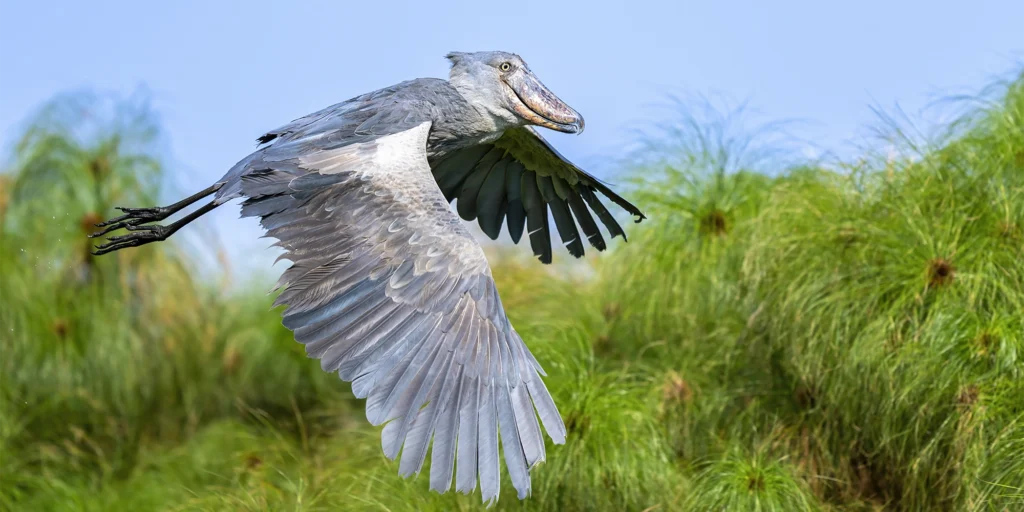
The Shoebill is deadly on land as it has the third largest beak in the world with razor-shaped edges. But, did you know it is one of the slowest birds in the air? This bird is known for its slow flight with 150 wing flaps per minute.
In the air, this bird flaps for approximately seven seconds and then seven seconds glides, and then again flaps for seven seconds and this cycle goes on. Shoebills mostly fly for short distances from 100 meters to 500 meters only.
8. Shoebill Stork Habitat: Where Can You Find Them?
Next is where to see shoebill storks in the wild. So, Shoebill storks are native to the African continent and are found primarily in eastern and central Africa including Rwanda, Uganda, western Tanzania northern Zambia, Sudan, and South Sudan.
The Shoebill Stork’s habitat includes marshes, wetlands, tropical river basins, and floating vegetation areas with tall grasses. Because of this, the Shoebill is known as the King of Swamps.
However continued wetland destruction and human interference have led to population declines due to breeding disruption, loss of nesting and feeding habitat, reduced prey availability, and poor growing environment for chicks. Pollution is also another cause of the decline in habitat quality.
9. Shoebills and Hippos: An Unlikely Alliance
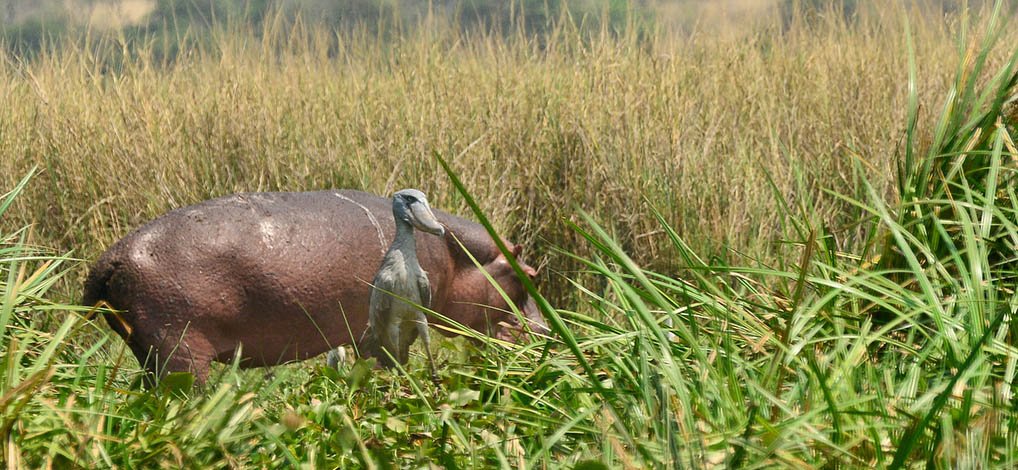
Shoebills use hippos to catch their prey. Shoebills usually position themselves where hippos are passing while hunting. When hippos move through swampy areas they disturb the area, disturbing vegetation and frightening fish and other aquatic animals into coming to the surface, becoming open and easy prey for the shoebill.
The hippo’s massive movements clear away all floating vegetation and clear water channels, allowing the shoebill to find its prey. The shoebill-hippo relationship is an unlikely alliance of wild, although the two creatures never meet face-to-face.
10. Shoebills in Ancient History and Folklore
“Abu Markub” is an ancient name for shoebill which means “father of slipper” and this reference comes from its distinctive shoe-shaped bill. Other than this, this creature may hold some place in Egyptian history and folklore because pieces of evidence suggest its appearance in hieroglyphics and Egyptian wall paintings.
Also, in Africa or especially in East African cultures, folklore, and legends, the Shoebill Stork is always viewed as a symbol of power, wisdom, strength, patience, and a guardian of swamps to bring balance to nature.
11. Shoebill Stork Sound: A Bird That Sounds Like a Machine Gun
Shoebill noise is another distinctive feature of this predator. This noise results from rapid bill-clattering, which produces a startling sound that resembles a machine gun sound. Yes, that’s right, if you hear this sound you might get confused, as it is exactly like a machine gun.
This bird uses this noise for mating and communication and the pitch of this sound varies according to different situations. Such situations are –
- Loud bill clattering noise – for territorial communication or to warn off other shoebills
- Synchronized bill clattering noise between male and female – shows courtship rituals and ready for mating.
- Low-pitched noise – Means parents are talking to their chicks
Shoebills are usually silent except during interaction this is due to their solitary nature and they hunt stealthily which also helps them conserve energy.
12. Shoebill’s Bizzare Cooling Strategy: Pooping on Their Legs!
Now the next interesting and weird fact about shoebills is that they poop on themselves, you heard that right. But this is a natural process known as urohidrosis and shoebills use urohidrosis to regulate their body temperature. In this behavior, the shoebill excretes urine and feces simultaneously, causing the liquid portion to evaporate, cooling its feet and body temperature.
The urohidrosis process is beneficial for the shoebill because they live in the hot African climate and shoebills do not sweat. Therefore, the excretion of liquid and white droppings can help reflect sunlight and reduce the risk of overheating. This natural process of urohidrosis helps them survive in the hot African climate.
13. Shoebill Mating & Monogamous Behavior

Even though the shoebill is ferocious, it is good at relationships. This bird forms monogamous relationships during the breeding season but it does not mean that they mate for life. Not only this, they protect their mates from other rivals.
Shoebills are quite territorial during their breeding season as they fight to safeguard their area for nesting.
Shoebills build their nests in swamps, wetlands, floating vegetation, or protected areas surrounding water where predators cannot come. Both partners participate in this nest-building process. Shoebills usually build three nests per square kilometer. Their nests are mostly large, flat, and up to 10 feet wide.
A female shoebill lays three eggs during the breeding season and the incubation period is 30 days. Both partners take turns incubating the eggs and splash water at eggs to keep them cool in hot weather. But here is an interesting thing, out of these three eggs, only one survives, usually the first or the strongest chick. The stronger child gets more food and water, and the weaker one is ignored, and this survival of the strongest chick results in siblicide.
14. Shoebill Sibling Rivalry: The Battle for Survival
Shoebill chicks engage in ferocious battles to establish their dominance. In this process, most of the time, the biggest or the strongest chick survives. And this is due to survival of the fittest as they do not have the luxury of unlimited resources and parental attention. This is also because the chicks develop slowly and during this time they are completely dependent on their parents for food and water. Since the shoebill parents spit out the food in their mouths before feeding the chicks. In this process, the stronger chick gets the main spot and food.
It’s not just that parents allow this process to happen because they let nature take its course as the stronger chick always survives in the long run. Constantly ignoring the weaker chick will result in its death. For the shoebill parents, this siblicide is nature’s decision.
15. Shoebill Stork Lifespan: How Long Do They Live?
The average lifespan of a shoebill stork in the wild is 35 to 40 years, which is long. They live so long because they are difficult to hunt and live in stable habitats. However, in captivity, their average lifespan usually increases to 50 years.
Although they live so long, their shoebill chicks take a long time, up to 4 years, to become independent. Since they are physically larger animals, they need more time to grow physically and develop their strength and skills. During this time, the chicks depend on their parents for food and protection. They gradually take small flights and learn all the necessary skills so that when they become independent, they are completely self-reliant and have the skills and strength to hunt.
16. Shoebill Conservation: Why They Are a Vulnerable Species
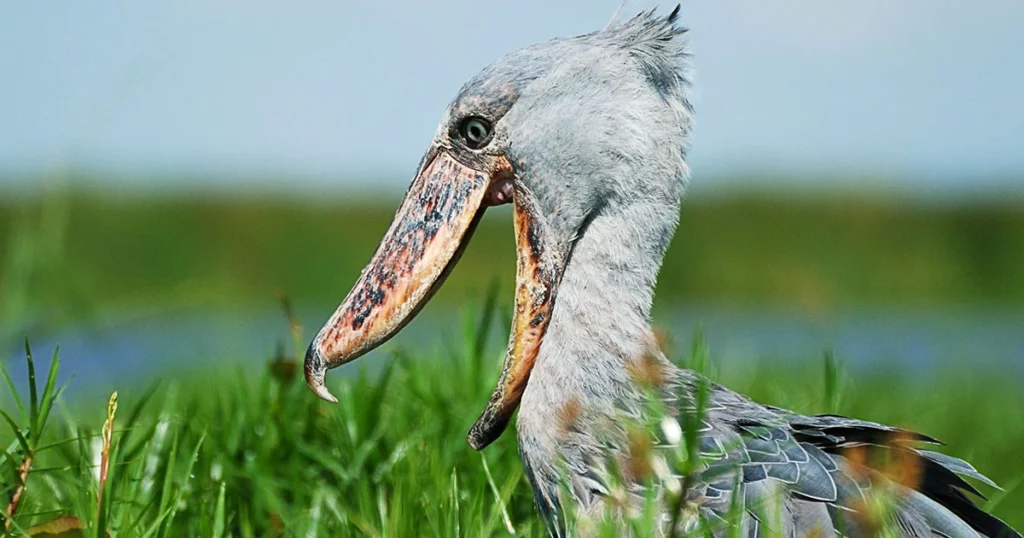
Yes, the Shoebill is an endangered and vulnerable species. Its population is declining, with a global population of 5,000 to 8,000 birds, of which 3,300 to 5,300 are adults.
The ongoing decline of this species is due to habitat loss or destruction, construction, disturbance, hunting, and pollution. Illegal bird trade and poaching also threaten the existence of shoebill birds. Therefore, it has been given the IUCN (International Union for Conservation of Nature) status of vulnerable species.
If intervention is not done now, the global population of this majestic bird will continue to decline. Not only this, the shoebill helps in maintaining the aquatic ecosystem and for this reason, the shoebill is also called the king of swamps. Hence, the shoebill’s habitats should be protected by supporting conservation programs.
Final Thoughts: The Shoebill Stork – A Nature’s Most Mysterious Bird
In conclusion, the Shoebill Stork is considered one of nature’s most mysterious and fascinating birds. Its fascinating prehistoric appearance, impressive size, and formidable hunting skills make it one of Africa’s most unique birds. Despite its intimidating demeanor and powerful beak, the Shoebill is a shy and solitary creature primarily focused on hunting in its marshy habitat.
If you get the chance to have a rare shoebill safari experience, head to the freshwater swamps of central tropical Africa, particularly the Mabamba Swamp or Ziwa Rhino Sanctuary in Uganda, or the Bangweulu Wetlands in Zambia. It will be a once-in-a-lifetime opportunity.
Unfortunately, habitat loss, destruction, human disturbance, illegal bird trade, and pollution threaten their populations. By contributing to conservation efforts and spreading awareness, we can help protect their natural habitats, promote awareness of their importance in the ecosystem, and implement measures to safeguard their future.
Because the Shoebill Stork is not only a fascinating predator but also a symbol of the incredible diversity of life on our planet.
